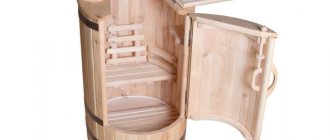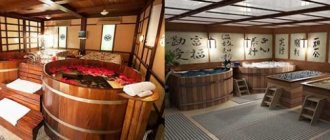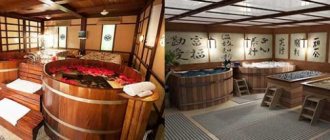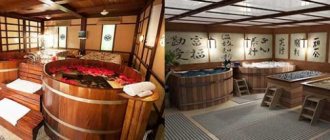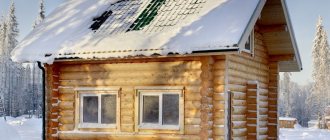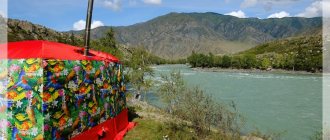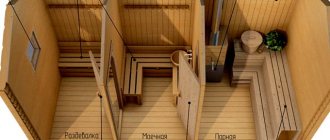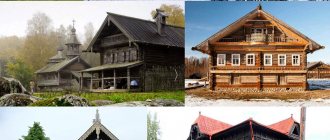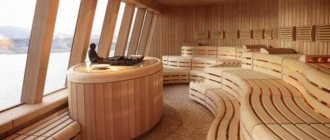From a technical point of view, the Japanese bathhouse was formed under the influence of four main factors: Buddhism, a dank climate with frosty winters, cold wooden houses with a free layout and the presence of geothermal springs. Buddhism did not allow the Japanese to wear the skins of killed animals, and to warm up in a house without internal walls and heating it was difficult.
By the way, there is still no central heating in Japan, although the country winters under the influence of Siberian air masses. The salvation was the hot springs that abound in this seismic zone. Those Japanese who were lucky enough to live next to underground boilers collected water in large wooden barrels and took a relaxing hot bath 3-4 times a week, or even daily. At the same time, immersion in hot water after a difficult hard day acquired philosophical meaning and special significance.
The way to achieve satori
There weren’t enough hot springs for everyone in Japan, so the Japanese did something simple: they placed a barrel of water on a wood-burning stove. Within a few hours, the barrel warmed up to the optimal “bath” temperature of 55 degrees, after which the head of the family washed thoroughly, and only then took a bath in the barrel, achieving satori. Such hot water was necessary to completely clean the body, since the Japanese did not use soap for the same reasons as they did not use the skins of killed animals.
Next, or together with the head of the family, children were allowed into the barrel, and last but not least, women. The water in the barrel was changed two to three times a month, and the container itself was covered with a wooden lid on top to prevent debris from getting in. A Japanese family-type bathhouse is called ofuro, and the barrel itself for taking wellness treatments is called furako.
This type of Japanese bathhouse is most widespread in Russian summer cottages - furako (the name is conditional, since manufacturers call it both ofuro and font) is now installed everywhere and used year-round.
In Russia, the Japanese bath is viewed more as entertainment rather than a ritual. However, this does not detract from the enormous therapeutic effect of furaco, if it is built according to the rules, and the bathing procedure itself is aimed specifically at improving health.
The furaco must have a bench for sitting and a footrest so that you can comfortably lean back and take a bath while reclining. The hot water should reach the middle of the chest so as not to create excess stress on the heart. It is recommended to wear a steam room cap soaked in cold water on your head, since a hot bath with a temperature of 55 ° C can cause unpleasant sensations if you are not used to it.
Russian furaco manufacturers offer two types of stove installation for the outdoor version: submersible, when the stove is located inside the barrel itself behind a wooden grate, and external. Stoves are usually wood-burning and made of stainless steel. The barrel itself is made of oak, cedar or larch, so that the phytoncides contained in the wood, under the influence of hot water, give a person their healing properties. A pine barrel is not suitable for furaco, because it will release resin, which is unlikely to improve your health.
In Japan, furako is made from only three types of evergreen Japanese cypress: sawara, manio hinoki and kiso hinoki. In Russia, an authentic furaco costs from 2 million rubles, and an ordinary garden font with a stove costs about 2 thousand dollars.
Relaxing in the spacious swimming pool
We put away our chair and the gang and head to the pool. One of the rules of sento is not to put your towel in the pool. It is usually placed on the head. Don't forget to also tidy up your bath supplies - gang and all - so that they don't disturb others. If the water in the pool is too hot, you can, with the consent of others, dilute it a little with cold water, but you should not make it too cool. Regardless of the size of the pool, swimming in it is not worth it.
Time to relax. When there are a lot of people, we try to give in to each other and not disturb others
There is no need to dip a towel into the pool. It is usually placed on the head
And on New Year's Day my friends and I go to sento
A little later, ofuro, large baths for the nobility, designed for several people, called sento, appeared in Japan. The role of a barrel in such a bath is played by a hot water pool, however, the procedure for carrying out the bath procedure itself remains the same. First you need to wash yourself completely, then douse yourself several times with water at a temperature of about 40 ° C to prepare your body for immersion in the pool, then you can immerse yourself in very hot water at a temperature of 55 ° C, where you will spend a maximum of 15-20 minutes. After this, they rub the body with a hard mitten to remove dead skin particles and disperse the blood, wrap themselves in a sheet and rest for about half an hour.
Then comes the turn of dry furaco with hot cedar sawdust and hot flat pebbles. In shape they resemble couches with high sides. You need to immerse yourself chest-deep in cedar or linden fine sawdust with the addition of rice bran, medicinal herbs and aromatic oil. The pores open completely and the relaxed body absorbs the essential oils. A person sweats in sawdust heated to 45°C; the sweat is completely absorbed into the wood chips, which are replaced with new ones after 5-6 procedures. Then you need to carry out the same 10-minute procedure, lying on a flat heated pebble, the heat from which has a beneficial effect on the spine, accelerates the blood, and, according to the Japanese, completes the healing procedure in the best possible way, simultaneously curing radiculitis, nephritis and chronic fatigue syndrome.
It is according to the sento principle that large stationary baths are usually built on personal plots.
Furaco
The shape of the Japanese bathhouse Furako resembles a very large barrel. Real cedar or oak is used to make the font. Only mature wood is used; the most suitable age of trees is from 200 to 500 years. For bathing procedures, the Furaco font is equipped with a bench along the entire internal perimeter. The dimensions of the barrel can vary markedly; procedures can take from 2 – 3 to 5 – 6 people. A visit to a Japanese bath can be an excellent end to a business meeting or negotiation.
To heat the water, a wood-burning stove is used, immersed in a font. To eliminate the possibility of burns, the oven is fenced off with a wooden partition. Traditional Japanese baths were heated by a wood stove . Now such a stove can also be used if there are no difficulties with organizing a chimney or the bathhouse is placed outside.
For installation in an apartment, the hot tub can be supplied with an electric stove. The electric furnace is mounted outside, water exchange is organized using 2 pipelines - one takes water from the font, the second supplies heated water back. The kit usually includes a water heating sensor.
The optimal water temperature for a Furaco bath is approximately +40-45 degrees Celsius . To achieve the desired effect, aromatic oils and incense are added to hot water. Don’t forget about the cedar from which the font is made. When heated, wood releases phytoncides into the water, which have a restorative and tonic effect on the human body.
After heating the water to the desired temperature and mixing the necessary additives, you can begin the procedures. It is recommended to take your time to dive into the font. Sitting on a bench, you can completely relax to smoothly relieve tension from your muscles.
The Ofuro bath procedure is very different from Furaco . Ofuro baths are rectangular in shape and are filled not with water, but with cedar sawdust. Any filler is heated to a temperature of +45 degrees and a person lies on it. The main effect on the human body in the Ofuro bathhouse is of a massage nature. It helps improve metabolism and weight loss. The total duration of the session is short and does not exceed 15 – 20 minutes.
In order to make the procedure more enjoyable, phyto-ingredients can be added to the sawdust. This will add a pleasant aroma and make the bath procedure even more beneficial.
Modern Ofuro baths have a thermostat to automatically maintain the set temperature. In accordance with the Japanese bath tradition, a visit to the pebble and sawdust bath follows the Furako .
Where does that miraculous power come from? Of course, the lion's share of the work falls on natural wood and the stove, which, interacting, will make the water in the barrel exactly as it should be. However, we should not forget that ofuro appeared in the Land of the Rising Sun , where more attention is paid not specifically to the process itself, but to how it happens. Therefore, in Japan, taking ofuro is a whole ritual that can be successfully repeated at home. The most important thing to do is to radically change your attitude towards the bathhouse. We are used to the fact that the bathhouse is a reason to meet with friends once a year on December 31st. But a Japanese bath is a necessary, almost daily cleansing/healing of the body. The Japanese never wash in it; they take a shower before entering the pool, often wiping the body with a soft washcloth. Ofuro is designed in such a way that when sitting in it, a person relaxes as much as possible, and his body opens up for healing. Thanks to this, hot water (40-45C) will penetrate every cell of the body and leave its beneficial trace there. Hot water relaxes your muscles as much as possible and gives them real rest. After this, relaxation occurs and the maximum therapeutic effect is achieved.
But it’s not just the opportunity to relax that made ofuro so popular in Europe. The ancient tradition of the Japanese is not just a tribute to history, but also a remedy. Thanks to ofuro, you can forget about stress and stimulate the functioning of the cardiovascular system and kidneys. It will relieve pain from rheumatism and normalize metabolism. Doctors have noticed that regular visits to ofuro greatly reduce the risk of colds . Thanks to a sufficiently high temperature, waste and toxins are removed from the body through the pores, the skin becomes smooth and elastic, and extra pounds are “cooked” right before your eyes. A Japanese bath can bring a huge amount of positive feelings and physical health. The most comfortable time to take an outdoor water bath “ofuro” is autumn, winter and spring.
While taking a bath, it is possible to use various aromatic oils, herbal infusions, and sea salts rich in minerals. People who truly love their body and take care of themselves, after systematically taking a bath, will see and feel that ofuro is an excellent addition to the daily care of their body and spirit. After all, the Japanese believe that a healthy spiritual and physical state is inseparable, therefore ofuro also has a deep philosophical meaning. During everyday work, we are constantly faced with many negative impressions that weaken our state of mind, in other words, stress. Ofuro, as the center of interaction of the four elements, will strengthen the energy background and make it resistant to external stimuli.
Pagoda or cube?
The technical structure of a Japanese bathhouse is no different from a Russian one. She needs water, electricity and a water or electric “warm floor - warm walls” system. Since your ofuro will be installed above floor level, there will be no particular problems with draining water.
The architecture of the Japanese bath is undemanding. In the land of the rising sun, they prefer simple and logical linear designs with a symmetrical arrangement of rooms and elements. The pagodas with which many of us associate Japan are, in fact, as exotic for the Japanese as they are for us: this is the architecture of Chinese religious buildings that appeared in Japan along with Buddhism in the second half of the first millennium. This is exclusively temple architecture, elements of which are rarely borrowed from civil buildings and are definitely not used in bathhouse construction. However, this is a matter of taste.
As a rule, a Japanese bathhouse is built in the form of a familiar log house with an open veranda, on which, by the way, you can install an autonomous ofuro for taking procedures in the fresh air. The attic space will be needed to accommodate utility systems, so it must be insulated.
The philosophy of ofuro, furako and sento
In the homeland of charming geishas and courageous samurai, three types of baths are practiced. True SPA fans prefer to use their own furaco bath, as well as ofuro with sawdust, at home. They are also presented as private mini-complexes and are designed to accommodate 1-2 visitors at a time. Sento, as a public water complex with huge thermal reservoirs, allows up to 100 or more connoisseurs of Japanese SPA care to take treatments together.
Regardless of the difference in design and proposed procedures, all Japanese baths are united by a single philosophy. Their essence lies in the therapeutic effect of the contents in the immersion container.
Where is Fujiyama?
To start building a bathhouse, it’s worth choosing the optimal location. If possible, the bathhouse is placed near a pond. If there is no open water nearby, then build a bathhouse in the depths of the site - as far as possible from the bustle and noise.
In this sense, it is much easier for the Japanese. The best way to achieve satori is by looking at the sacred Mount Fuji: its contemplation has a beneficial effect on the way of thinking and the state of the soul. This option is not suitable for us, however, if you intend to use the veranda to relax after sento, think about what would be more pleasant to look at.
After the bath we replenish the lack of fluid in the body
Before going to the locker room, you should wring out the towel and dry yourself thoroughly. Entering the locker room leaving wet footprints behind is very uncivilized. A fan will help you cool down and dry, and wipe off any excess sweat with a towel. When we stop sweating, we change clothes. After the bath, milk or other drinks that can be purchased from the construction site go very well to replenish the lack of fluid. If you find yourself at Takaraya, Furo Wakuzo especially recommends relaxing on the veranda (engawa) after the bath and admiring the garden. It is very good to combine drinks and leisurely relaxation on the veranda.
Leisurely rest on the veranda from the men's department
Sento usually sells bottled drinks - milk, café au lait, fruit milk drinks
Diameter determines perimeter
The Russian saying “let’s start from the stove” does not apply to the construction of a Japanese bathhouse. In this case, you need to start from the furaco, or rather, from the diameter of the wooden font that you choose.
Traditionally, a Japanese bath is square in shape and is divided into four rooms: two large and two small. The first large room is the ofuro itself, where there are fonts and furaco with sawdust and pebbles, the second is a hall for relaxation and a tea ceremony. Small rooms are the hallway, as well as the shower room, where you need to wash yourself well, since people enter the ofuro with a clean body.
Traditionally, the ofuro is equipped with two large pools of water, which are united by a common podium, and two dry furaco with sawdust and pebbles, which are electrically heated and have a thermostat to maintain a 45-degree temperature.
Large furaco for water procedures can have different diameters, it depends on how many people plan to take a bath at the same time. Traditionally, the diameter of one furaco is 1100–2000 mm. Consequently, the width of the room in the ofuro should be optimal to accommodate two adjacent fonts.
The presence of two furakos is again explained by the Japanese tradition: before immersing yourself in hot water and relaxing, you need to accustom your body to the temperature effects in a cooler bath. The temperature difference is 15-20 degrees.
In total, taking into account the diameter of the furaco, the width of one room should be at least 3 meters, therefore, the width of the bathhouse is 6 meters, and if we install a standard square bathhouse, then we need a log house 6x6 m, excluding the veranda. These are the minimum requirements for a Japanese bath. Moreover, this option does not take into account the massage room.
The rooms are arranged in such a way that from the hallway you can get into the shower room, then into the ofuro, then into the tea ceremony room, from which you can exit again into the hallway.
We wash ourselves clean and go into the pool
To the side of the entrance we take a bathroom chair and a washcloth and go to the washing areas and sit down in front of the tap. You should wash yourself thoroughly before entering the communal pool. Try to wash so that the water from your shower does not get on other people. If the tap water is too hot, dilute it with cold water.
Before entering the pool, you need to wash yourself well. If you leave the wash area, put your bath items where they won't be in anyone's way.
Mosaic, tea ceremony and sabi-wabi
The hallway in Ofuro is not too fancy. The only mandatory requirement that Japanese interior style places on it is built-in wardrobes. The Japanese bath does not like loosely hung clothes and open sections for storage.
By tradition, complex mosaic floors, stone, and expensive wood are allowed in this room. However, the most common and stylish design option is a continuous, almost without transitions, cladding of all surfaces with small mosaics. In this case, as a rule, two benches, a shower stall and a chair with a foot bath are installed in the shower room.
In the shower room, in addition to a warm water floor, it is optimal to install a water heating system for the walls, “stone” benches and chairs.
Continuous mosaic cladding is done after wooden (or brick-built) benches and an armchair are sheathed with polymer panels, for example, sheets of polymer cement. It bends perfectly and is very easy to install. The polystyrene in its composition provides the necessary waterproofing. Since such panels provide a good leveling base, tiles and mosaics are laid directly on them.
These same stone benches will serve as excellent massage tables. The room for the tea ceremony is also not easy. In the classic version, it is almost devoid of furniture. However, this is a distinctive feature of all Japanese interiors - people sleep, eat and sit on mats. For a Russian person, especially after a magnificent ofuro bath procedure, this option is hardly suitable.
If you are not a fan of the Japanese tea ceremony, then there is no point in following exact instructions for building a tea room. It is quite possible to limit ourselves to stylization. To do this, it will be enough to follow simple rules. The room is zoned due to movable screens, lighting, and different textured floors. Natural materials have minimal processing, but are complemented by unique handmade decorations. Things are stored in built-in wardrobes or traditional Japanese chests, maximum free space, minimum furniture. The restrained color palette is limited to natural tones. Soft and dim lighting imitates daylight passing through closed curtains.
Japanese bath - what is it?
Looking at the interior of a Japanese bath for the first time, you may be surprised, because it is not at all similar to ours. It looks more like a large bathroom or sauna. It contains wooden baths of various shapes and beds for relaxation, but there are no brooms or a room for a steam room. Everything related to active washing is absent here. The reason for this is that the Japanese bath is based on the philosophy of Buddhism.
The purpose of visiting is primarily to improve your spiritual health. Relax physically, forget about all worries and problems, feel calm and tranquility. In this state, healing of the body and psyche occurs, as the mind comes into contact with the spiritual center.
Way of the Samurai
The bath ceremony in Japan is a whole philosophy. This explains the special attitude towards ofuro. It is in the traditions of this people to find a philosophical and epic beginning in every pleasant procedure, be it tea drinking or ablution. Bath, in accordance with Japanese traditions, is a combination of the four elements that make a person invincible. Ofuro combines fire, water, earth (wood) and air. A person who has gathered these elements into a single whole becomes an absolute warrior. With these thoughts in mind, you should visit a Japanese bathhouse, even if it is built on your personal plot.
“Construction Rules”, No. 26/1, December 2011
The copyright holder of all materials on the site is Construction Rules LLC. Full or partial reprinting of materials in any sources is prohibited.
Ofuro in detail
The modern Ofuro bathhouse is a rectangular box made of natural wood. This structure is filled with mineral water from thermal springs or hot sawdust. In some cases, sea stones or cedar cones are added to the barrel.
The barrel is an integral attribute of relaxation procedures in Japan. The average temperature inside is about 30-60°C, which is quite enough for a feeling of comfort, relaxation and absolute relaxation. In Japan, steam rooms of this kind are installed in private houses and even apartments, and in Russia they can be found in spas, bath centers, health centers, cosmetology clinics, etc.
The ofuro bath is considered the best treat in the Japanese home and a proven medicine for treating ailments.
Classic barrel size: 200x80x80 cm. Modern ofuros are connected to an electrical power source, thanks to which you can regulate the heating temperature of the “insides” (be it sawdust, water or stones). Inside each barrel there is a thermal insulation composition. To achieve the best effect, sawdust can be mixed with essential oils, herbs, minerals, as well as crushed wood and pine cones. Thus, inside the steam room contains a real elixir of useful and well-chosen ingredients!
How to choose and make?
Like any improvement of a home or garden plot, the implementation of the idea of a bathhouse begins with design. First of all, you need to decide on the location and size. There are several options, each of which finds its adherents and is successfully implemented in practice:
- a bathhouse attached to the house;
- independent bathhouse building;
- a separate barrel of furaco on a personal plot under a canopy or in a barbecue area.
Based on these aspects, the parameters of the bath are calculated, the approximate sizes of objects and the amount of necessary materials are determined.
Making containers for a Japanese bath is quite a troublesome task. If you do not have certain carpentry skills, then it is better to purchase finished products in a specialized store or order from suppliers. This will save time and labor costs and also guarantee quality. This is especially true for a voluminous barrel of furaco, which must be airtight.
If the area of the site allows, then the best option would be a separate building for a bathhouse. For fire safety purposes, it should be located at some distance from the house and other outbuildings. However, if all rules and regulations are observed, the bathhouse can be attached to the garage, the first floor of the house.
The bathhouse construction project also includes the necessary departments of the future bathhouse complex. So, depending on preferences, a bathhouse may include a washing room with a shower, a dressing room (dressing room), a relaxation room for tea drinking and gatherings with guests, and a veranda.
For a separate building, it is necessary to think over a water supply system, water drainage (sewage system, place for a septic tank), and lighting. The ventilation system is one of the most important elements of a bathhouse design. Comfort in the room and the level of humidity, which affects both the quality of bathing procedures for humans and the safety of wood materials, depend on its proper operation.
Bathhouse with horizontal orientation
Ofuro, the Japanese bathhouse in this regard is a little closer to the heroine of this part of our story, but that’s where the similarities, by and large, end.
The bathhouse in the form of a barrel is rather a product of folk art, inspired by the life path of the legendary Greek philosopher Diogenes. Despite some parody and caricature, which appear at first sober glance, it has a number of useful, functional, and in some ways simply pleasant aspects:
- High mobility. Due to their small size and compact dimensions, barrel-shaped baths are very mobile. This is where their high popularity comes from when installing a steam room on a wheeled chassis, both cars and trailers;
- The small volume of the interior allows you to quickly and efficiently warm up the bathhouse to the nominal temperature without consuming an excessive amount of fuel. According to some experts from the field of construction, the efficiency of baths of this type is 24 - 28% higher than that of traditionally designed objects;
- High structural strength. As you know from the course “Strength of Materials,” a sphere is one of the strongest geometric shapes, evenly distributing all linear and dynamic loads. In addition, based on the light weight of the finished product, you can get by with a simple foundation, without any special consequences for the bathhouse as a whole;
- Low construction cost. The one-volume structure amazingly combines floor, ceiling and walls, smoothly transitioning from one plane to another. This feature implies excellent heat distribution without the formation of “pockets” and unheated zones. Waste disposal is not a problem, thanks to ideal conditions for collecting water from all surfaces;
- Attractive appearance. Built with soul and playful sparkle, such a bathhouse will decorate any area, even the most picturesque one.
Some projects in which a round barrel bath appears include only a steam room, moving the dressing room, relaxation room, and often the vestibule outside the building itself. This design echoes the first baths, which began to be used by mankind and were heated using black heat.
Beautiful examples and options
For those who do not strive to design a bathhouse in the classic Japanese style and are mainly interested in the therapeutic process itself, you can consider the options of creating ofuro and furako from scrap materials. Having a creative streak and a little imagination, you will have a completely budget-friendly set of health treatments at your dacha.
A decorated old bathtub, with a stainless steel stove installed underneath, can serve as a font. A rectangular box for ofuro and a summer shower can be installed directly outside on an open area or terrace.
A furaco barrel will be perfectly used next to a barbecue area. This option will make spending time with friends even more interesting. By the way, furaco can be used outdoors even in frosty winter, plunging into a barrel as if into a hot natural spring.
In some Europeanized versions, there are furaco models, where the wooden barrel is replaced with a cast iron vat, which can be decorated with large stones and stylized as a fabulous antique.
You can find out how the installation of a sauna font takes place by watching the video below.
Ablution procedure
The Japanese bath has its own traditions and rituals.
The visitor is placed in the font so that the water is below the heart. Even then, the heart rate usually increases and blood pressure may rise significantly. If the rules are not followed, the consequences can be very serious. Staying in furaco should not exceed 15 minutes. In such a short period of time, metabolism in the human body is stimulated, the functioning of the heart and blood vessels is noticeably improved, and immunity is increased. Experts say that this Japanese bath can cure diseases of the kidneys, joints, heart, as well as colds. Hot water has a beneficial effect on the skin, opens all pores and removes accumulated toxins through them. To make the effect even more powerful, extracts of various herbs, aromatic oils, rose petals, and salts are added to the water.
After the allotted time has passed, the visitor moves to the couch. His rest should be at least an hour. At this time, his body completely relaxes, the nervous system returns to normal. The Japanese furako bath is a real ritual. It seems to combine four elements - Air (steam), Fire (heat), Water and Earth (wood). Tradition says that only he can become a real warrior who is able to combine these elements together.
Benefits and contraindications
The fact that the people of Japan differ in their life expectancy once again proves that their baths are very, very useful.
- The Japanese bath process makes a certain contribution to this age-related achievement. However, in addition to the advantages, there are also negative aspects.
- For example, it is not recommended to visit the bathhouse if you have skin diseases, epilepsy, high blood pressure, cancer or chronic diseases.
- Pregnant women should also not get carried away with such water procedures.
Those who have problems with tolerability of individual components should also be wary. In such cases, consultation with a doctor is simply necessary.
Ofuro box design
At first glance, it is a simple wooden box. But it is designed for regular heating to 60 degrees. Even the pickling barrels dry out during the summer months. They must be soaked before use. Wood “walks” when temperature and humidity fluctuate.
Metal and plastic fasteners are not allowed in the ofuro box. Requires the skill of Japanese carpenters. So that the wooden bathtub does not dry out or crack on the first day of use.
Japanese woodworking
Japanese carpenters did not use glue or nails. To connect the wooden parts, grooves and tenons were precisely adjusted. The cross-section of the connection has a complex profile. At the same time, they did not use sandpaper or drills. Precision fitting was achieved with a limited set of tools.
The art of creating strong wooden joints is called tsugite. Today, such precision of parts is achieved on CNC machines. Manufacturers of equipment for furaco baths use thermal wood. It is obtained by drying lumber at high temperatures. Thermowood does not dry out or swell from moisture.
